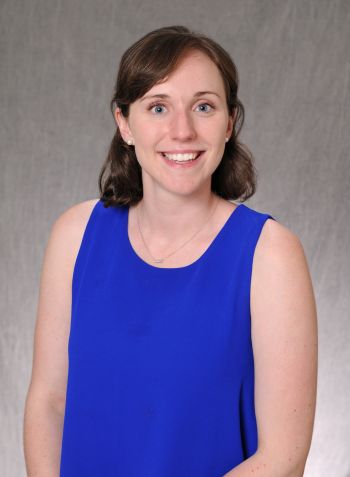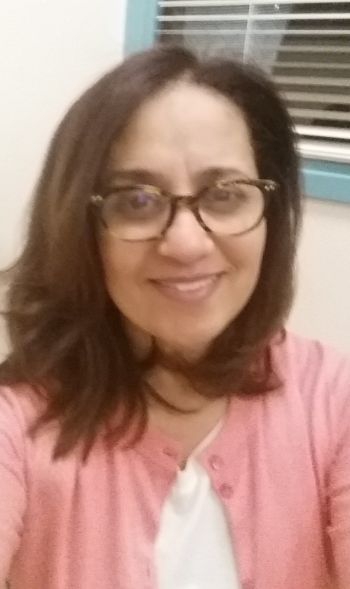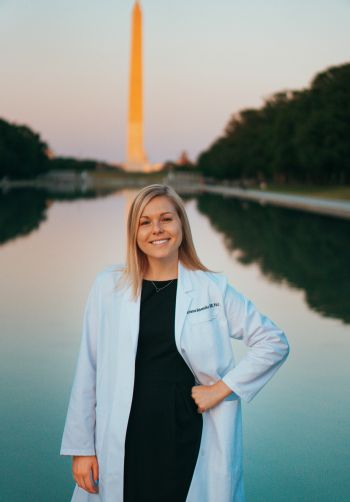In early December on her drive home from the hospital, Caroline Thomas, MD ’20, an OB-GYN resident at Anne Arundel Medical Center, reflected on the day’s shift in the ICU amid the COVID-19 pandemic: She did rounds, she checked on patients on ventilators and worked to try to get them off of the ventilators, she pronounced patients dead, and she spoke with and comforted family members.
Less than 40 miles west of Anne Arundel, Maryland, at the George Washington University (GW) Hospital, Diana Wilbur, DPT ’19, spends her days shifting COVID-19 patients into prone positions to allow for easier breathing and working across disciplines to help provide patients with the best care possible.
In a lab at the National Institutes of Health (NIH), Loraine Goldsboro, MSHS ’18, sits not at her usual hematology bench, but at the new COVID testing lab, working diligently through hundreds of samples in an effort to ensure there is no spread of the virus among the employees who work for the government agency.
Kristin Schoenike, PA ’20, rounds on her ward at MedStar Washington Hospital Center, masked and gloved. She is always on the lookout for signs of COVID among her patients, ready to ensure they get tested and the proper precautions are taken should they show symptoms during their hospital stay.
There was no way for these GW School of Medicine and Health Sciences alumni to know they would be spending the early years of their careers in such a historic and hectic moment. They didn’t know the challenges they would face, but in spite of it all, each one is making an important difference, helping their patients and their colleagues as the world fights against this enemy.
Caroline Thomas: Riding the Waves of COVID-19 Cases

Anne Arundel Medical Center.
When Thomas started at her job in July, the early summer wave of cases had crested and started to recede, but there was still a lot of work to do and a lot to learn in the OB-GYN unit.
“There was still a lot of unknown in the obstetrics world,” she notes. “How to treat women who were COVID positive, when to test women to see if they were COVID positive, and once they delivered, there was concern about whether the virus could pass through the placenta.”
She says there was a lot of fear, and getting used to wearing a mask while treating patients was difficult, but the understanding and collaboration across the unit and the hospital helped flatten the learning curve.
As winter edged in and gatherings caused cases to rise, Thomas also was assisting in the ICU, watching patient loads increase and those in her care grow sicker – and having that weigh more heavily on her.
“We have patients we lose, or patients placed on ventilators [who] are on them for many weeks. That was three of my patients today, trying to get them off of ventilation and failing again,” she says.
Thomas also has to comfort families, those who lost someone or wanted to speak with a loved one they cannot go visit in person. “I have to say, ‘I’m sorry you can’t be on the iPad right now to talk with your loved one because someone down the hall is passing away and needs to talk to someone or has their family on a call,’ ” she notes, exhaustion seeping into her voice.
“It’s hard to compartmentalize, especially as young physicians,” Thomas says, but adds that she has many people she can lean on when things get tough, including her fellow residents and mentors.
“My program is very supportive and prioritizes wellness,” she says. Her team has come up with different ways to ease the burden. “We’re going to do a guided meditation over Zoom and have a gingerbread house competition; it is the little things that get us through.”
Loraine Goldsboro: Pinch-Hitting from the Bench
Goldsboro has been working at the NIH for a little over a year and a half, primarily on the hematology bench.

But in March, the NIH sought volunteers for the COVID testing team.
“I volunteered and have been helping ever since,” she says. “I wanted to help. This is such a big deal, is effecting all of us. Also, I have always been the type of person to want to spread my wings and learn more, so it was my opportunity to venture outside hematology.”
At first Goldsboro helped with performing molecular based testing primarily for patients. After some time doing that work, she moved to assisting with pooling of testing samples for employees.
“We started out with the employees with nasal pharyngeal samples,” explains Goldsboro. “So we would pool 10 samples into an empty tube and run that tube. If the pool sample comes out negative for COVID-19, we know those samples were all negative. If it’s positive, then we test each sample individually to ID which of those employees tested positive.”
She also recently began doing testing of salvia samples, which are pooled in groups of five.
“In the beginning we were pooling around 100 samples, so about 10 pools, but now we have over 1,000 in our daily shift,” she adds. “I’ll be here as long as they need me.”
Goldsboro adds that she also facilitated the fall molecular diagnostic course at GW and used what she learned in the testing lab in her lessons. “My master’s from GW is in molecular diagnostic science, and that was another thing that motivated me to help, I could gain more experience in molecular testing itself,” she notes.
Diana Wilbur: Helping through an Historic Moment

Wilbur works in the acute care, medical surgery side of GW Hospital, helping patients with functional mobility to help get them home again.
Her actual work remained much the same when COVID-19 struck, but there was one big difference: her patients were now those suffering from the virus.
“It changed the daily environment, where it became more stressful and more challenging,” she says. “But it gave me the opportunity to work with more critically ill patients. I’m not yet ICU certified, but that’s one of my goals, and during this pandemic I’ve been working with patients who have acute respiratory distress.”
One thing she learned early on was the practice of proning, which is done to help a patient to lie on their stomach, helping patients struggling with oxygen exchange by increasing blood circulation and bringing air into different parts of their lungs, she says.
Wilbur says it’s been inspiring to see all of her colleagues from varied specialties and with varied experience jump in to work together and help patients to the best of their abilities.
“It’s a group effort, no doubt about it. We’ve had a speech therapist transition to the respiratory team,” she explains. “Also, with the absence of visitors and these patients not being able to see their families, we’ve had to step up and providing comfort to people and give them some social stimulation.”
Wilbur adds that she never anticipated her career starting out this way. But she remembers stories told by her grandmother, who was a Red Cross worker in WWII.
“She would tell me stories, and this is not the same as that work, but I always found them so interesting,” she says. “I never thought I’d live through times that in some ways would echo that historic moment she lived in and worked through.”
Kristen Schoenike: Managing Patient Care in the Midst of COVID-19
Working with the hospitalist team at MedStar, not all of Schoenike's patients are COVID-19 positive, but nevertheless the pandemic has touched so many parts of the work she does.

Her day-to-day work consists of rounding on her patients, about eight patients who she usually follows throughout the week. “Every day it’s reading through their chart to understand why they’re in the hospital, what’s been done since they’ve been admitted, and then coordinating their care moving forward,” she explains.
But due to COVID, there are many more policies and procedures in place. One example, she says, is giving patients a COVID-19 test two days before any operations
“Things like that are new to us, extra lines on our checklist that need get accomplished for patients during their hospital stay,” she says.
In addition, Schoenike has to be on alert when caring for her patients that they don’t show signs of COVID-19.
“When a patient spikes a fever, it could be for many different reasons, but now we really have to take seriously into account whether it’s COVID-19. Then if you do think someone is showing symptoms of the virus, you need to test them. If a patient is tested they become a person under investigation and need their own room, so from a bed management perspective it creates added burden,” she says.
She also worries about the risk she could be in working in the hospital, and the risk that could create for those around her, but despite that, her love for medicine has not wavered.
“I believe in my work and I love my work. … Starting your career in a pandemic hammers home why you’re doing this. You go into medicine because you want to make a difference in patients’ lives, and this pandemic makes that very real.”




